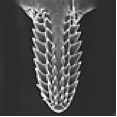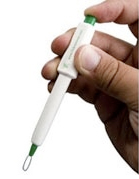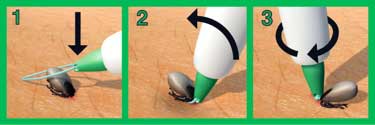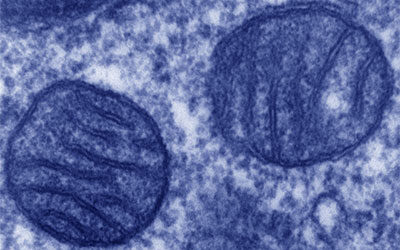There are many theories as to how to remove a tick that has become imbedded in the skin. We now know that most of them are incorrect, since the majority of ideas actually cause the tick to regurgitate (vomit) more bacteria into your body as you try to extract them.
Some of these erroneous tick removal methods:
- Putting essential oils, nail polish or remover, or any other substance on the tick to agitate it and cause it to pull itself out, all of which cause the tick to vomit before backing itself out of the skin.
- Using tweezers or the fingers, gripping as close to the head as possible. This sounds good until you attempt to do it without crushing the head, which often leaves the ticks mouth piece still embedded in the skin and still squeezes more juices into the your body.
- Holding a match over the back of the tick is an obvious mistake as it definitely causes the tick to vomit from the agitation.
Here is the best way to remove a tick and why it works the best. To understand why this works the best, study the structure of the mouth portion, called the hypostome and pictured here, generously provided by the Trix® Tick Remover company. The serrated teeth will hold tight with virtually any pulling action. However, they will literally fold flat if they are rotated in either direction.
 If you ever wondered how the tick removes itself after it has finished feeding, now you know – it twists the teeth flat!
If you ever wondered how the tick removes itself after it has finished feeding, now you know – it twists the teeth flat!
I recommend only one type of tick remover, the patented TRIX Tick Removal System®, made in Sweden by InnoTech. This device is available through various distributors worldwide (tickremover.com) and through the Hansa Center, click to purchase now online.  I like to keep the TRIX® in several places so that I can use it as soon as I find a tick on myself, others, or on a pet. You may want to buy several to keep in your backpack, kitchen drawer, auto glove compartments, boat, RV, fishing tackle box, hunting jacket, barn/horse stable/kennel, and where you work. Obviously, it is best to have a TRIX® handy when you first notice a tick embedded in the skin.
I like to keep the TRIX® in several places so that I can use it as soon as I find a tick on myself, others, or on a pet. You may want to buy several to keep in your backpack, kitchen drawer, auto glove compartments, boat, RV, fishing tackle box, hunting jacket, barn/horse stable/kennel, and where you work. Obviously, it is best to have a TRIX® handy when you first notice a tick embedded in the skin.
Here is the premise of the TRIX® tick remover:
- The Tick Remover is working by the lasso principle. It is very fast to adapt and therefore easy to use on children and pets, who sometimes find it difficult to hold still.
- The design makes it easy to use in ears, thick fur and other difficult places. The remover also works very well even if fur or hair comes into the loop.
- The removed tick is always stuck at the tip of the remover and can be disposed of easily. The loop is made of special fiber which has a pull strength of more than 20 pounds. The loop is big enough to take care of most tick species in the world.

The following is from the User Manual for the revolutionary TRIX® tick remover:
TRIX is a very effective remover which easily and safely can remove the whole tick, big or small. Even the smallest tick nymph is easy to remove with this tool.
![]() Press down the loop and pull it over the tick, as close to the skin as possible.
Press down the loop and pull it over the tick, as close to the skin as possible.
![]() Let go of the button and titlt the tick remover perpendicularly against the skin.
Let go of the button and titlt the tick remover perpendicularly against the skin.
![]() Keep the green point against the skin and turn it one round between your fingers. Lift away.
Keep the green point against the skin and turn it one round between your fingers. Lift away.
![]() If it is a very small tick: Place the green point close to the tick and press the point down a little into the skin to angle up the loop. Release the button, twist and life away.
If it is a very small tick: Place the green point close to the tick and press the point down a little into the skin to angle up the loop. Release the button, twist and life away.
 1. Twist the tick away
1. Twist the tick away
If you look at the photomicrograph of the ticks sting and suction organ (hypostome) you can easily see that if you pull straight out the barbs grip and get even more stuck in the skin (that’s what barbs are for). The risk of pulling the tick apart increases. If you twist instead the barbs will release their grip easier and all of the front part together with the head can come along. Tests have shown that it does not matter what direction you twist, clockwise or counterclockwise gives the same good results.
2. Twisting also reduces pain
When you pull a tick away, it causes some pain in the skin which may cause some pets to really dislike the treatment. But if you twist it away with a tick remover which keeps the mouthpart in a firm grip, the removal will be painless and the pet usually do not even notice because the bite area is stunned by the tick.
3. Always twist the tick away when using TRIX TickLasso:
- It’s faster.
- Gives less pain.
- Safer complete removal of whole tick.
- Decreases the risk of infections.
Excerpted from the book Beating Lyme Disease: Living the Good Life in Spite of Lyme by Dr. David Jernigan.
What is your experience with tick removal?









The Trix tool is OK on big, fat adult ticks but useless on the tiny ones. It just crushes them. The loop is too thick and if you use it on animals it bunches up the fur, compressing the tick. I use the Tick Twister and the small tool will even get the larva out. I’ve removed hundreds of ticks using all kinds of tool and the Tick Twister is the one that always works for me and the one I always carry.
Thanks Denie, for sharing that. Here is a video showing how the Tick Twister (ticktwister.com) works. It seems to be the same concept as the TRIX® tool recommended by Dr. Jernigan, but instead of a loop, uses the shape of the tool to twist ticks off. Very helpful!
I’m in the UK so I get mine from the Lyme disease charity Borreliosis and Associated Diseases Awareness UK (http://www.bada-uk.org/). I got to know about this charity after seeing them at a country fair near me. As a Lyme sufferer I was interested to talk to them and they had the Tick Twister available. I bought my first set (you get large and small in a pack for the different tick sizes) and I now have one set in my car, my first aid kit at home, at my stables and in my bag! I’ve given so many away that I keep having to replace them. Lol.
For people outside the UK and Ireland, BADA UK have a list of suppliers in other countries on their website. Hope this helps!